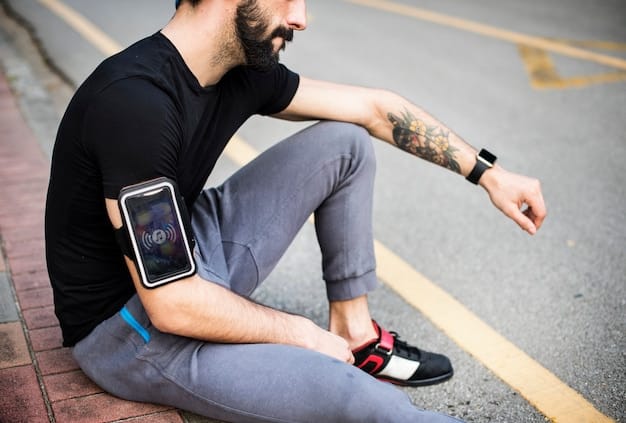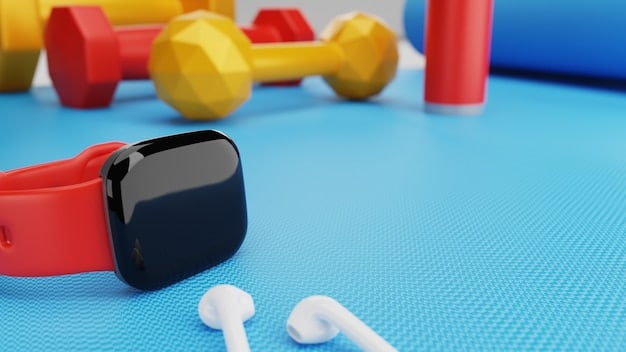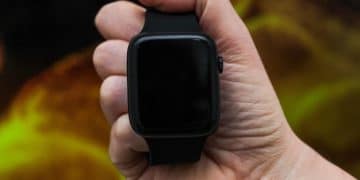How to Choose the Best Smartwatch for Your Needs in 2025

A smartwatch can be a valuable addition to your tech collection, offering fitness tracking, notifications, and more, but selecting the best one requires careful consideration of your specific needs and preferences.
Choosing the right smartwatch in 2025 can feel overwhelming with so many options available. This guide walks you through the key features to consider, ensuring you find the perfect wearable companion for your lifestyle.
Understanding Your Smartwatch Needs
Before diving into specific models, it’s crucial to understand what you want from a smartwatch. Consider your daily activities, fitness goals, and preferred level of connectivity to narrow down your choices effectively.
What functionalities are most important to you? A smartwatch can be a powerful tool for fitness enthusiasts, busy professionals, or those seeking a convenient way to stay connected.
Fitness Tracking
If you’re a fitness enthusiast, prioritize smartwatches with advanced sensors for heart rate monitoring, GPS tracking, and activity recognition. Look for features like sleep tracking and workout analysis.
Notifications and Communication
For those who need to stay connected, consider smartwatches that offer seamless notification syncing, call answering, and even the ability to send quick replies from your wrist.
- Battery life: How long do you need the smartwatch to last on a single charge?
- Display: Do you prefer a bright, always-on display, or are you willing to sacrifice that for longer battery life?
- Operating System: Are you an Android or iOS user? Choose a smartwatch that is compatible with your smartphone.
By carefully evaluating your needs, you’ll be better equipped to choose a smartwatch that enhances your daily life. Consider these factors to make an informed decision.

In summary, understanding your personal needs is the first and most important step in choosing the best smartwatch for you. This personalized approach will help you narrow down the options and find a device that truly fits your lifestyle.
Operating Systems: watchOS, Wear OS, and Others
The operating system (OS) is the heart of any smartwatch, dictating its user interface, app availability, and overall compatibility with your smartphone. The two dominant players in the market are watchOS (Apple) and Wear OS (Google).
Choosing between watchOS and Wear OS can significantly impact your experience. Understanding the strengths and weaknesses of each OS is essential for making the right choice.
watchOS (Apple)
watchOS is exclusive to Apple Watch and is known for its seamless integration with iPhones. It offers a clean and intuitive interface, a vast app ecosystem, and a strong focus on health and fitness features.
Wear OS (Google)
Wear OS is compatible with both Android and iOS devices and offers a more open and customizable experience. It boasts a growing app store, Google Assistant integration, and a wider range of hardware options.
- Proprietary OS: Some manufacturers use their own operating systems, often prioritizing battery life and core features over app availability.
- Compatibility: Ensure the OS is compatible with your smartphone’s operating system.
- App Ecosystem: Check the availability of apps you use regularly.
Ultimately, the best OS for you depends on your smartphone preference and desired level of customizability. Consider the trade-offs between integration and flexibility.
In conclusion, the operating system is a fundamental aspect of a smartwatch. Selecting an OS that aligns with your device ecosystem and usage preferences guarantees a smoother and more satisfying user experience.
Key Features to Look For
Beyond the operating system, smartwatches come packed with various features designed to enhance your daily life. From health tracking to communication tools, understanding these features can help you choose the right model.
Prioritizing the features that matter most to you can significantly simplify the selection process. Consider what you intend to use your smartwatch for most frequently.
Health and Fitness Tracking
Heart rate monitoring, activity tracking, sleep analysis, and blood oxygen saturation (SpO2) sensors are common features in fitness-focused smartwatches. Some models even offer advanced features like ECG and fall detection.
Connectivity
GPS, Wi-Fi, Bluetooth, and cellular connectivity (on some models) allow you to stay connected even without your smartphone. Cellular connectivity enables calls, texts, and data usage directly from your wrist.
- NFC: Near Field Communication for contactless payments.
- Water Resistance: Essential for swimmers and those who wear their smartwatches during workouts.
- Microphone and Speaker: For taking calls and using voice assistants.
By carefully evaluating these key features, you can identify the smartwatches that align best with your lifestyle and needs. Prioritize features that genuinely enhance your daily activities.
In conclusion, understanding the key features available on smartwatches can help you make a more informed decision. By prioritizing the features that are most important to you, you can find a device that truly complements your lifestyle.
Battery Life Considerations
Battery life is a crucial factor to consider when choosing a smartwatch. The battery life of a smartwatch can vary widely depending on the features you use and how often you use them.
A smartwatch with longer battery life can offer greater convenience and reduce the need for frequent charging. Consider how often you are willing to charge your watch.
Usage Patterns
Heavy usage, such as constant GPS tracking or frequent calls, will drain the battery faster. Evaluate how you plan to use your smartwatch and choose a model that can keep up with your usage patterns.
Display Type
Always-on displays are convenient but consume more battery. Consider whether an always-on display is essential for you, or if you’re willing to raise your wrist to activate the screen.
- Battery Capacity: Check the battery capacity (mAh) and manufacturer’s estimated battery life.
- Charging Time: Consider the time it takes to fully charge the smartwatch.
- Power Saving Modes: Look for smartwatches with power-saving modes to extend battery life when needed.
Choosing a smartwatch with sufficient battery life is essential for a positive user experience. Balancing features with battery performance is crucial for finding the right fit.
In summary, battery life is an important consideration when choosing a smartwatch. By considering your usage patterns and the battery-draining features, you can choose a smartwatch that meets your needs.
Design and Comfort
A smartwatch should not only be functional but also comfortable and aesthetically pleasing. The design and comfort of a smartwatch are crucial for daily wear, as it is a device you’ll likely wear all day.
Consider the materials, size, and shape of the smartwatch to ensure a comfortable fit on your wrist. A well-designed smartwatch should feel lightweight and unobtrusive.
Materials
Smartwatches come in various materials, including aluminum, stainless steel, titanium, and plastic. Choose a material that suits your style and is comfortable against your skin.
Size and Shape
Consider the size and shape of the watch face. Smaller wrists may benefit from a smaller watch face, while larger wrists can handle larger models. Round or square faces are a matter of personal preference.
- Band Options: Check for interchangeable bands to customize the look and feel of your smartwatch.
- Screen Protection: Look for durable screen materials like sapphire crystal or Gorilla Glass to protect against scratches and impacts.
- Customization: Consider the level of customization available for watch faces and other settings.
Finding a smartwatch that combines functionality with a comfortable design is key to long-term satisfaction. Prioritize a design that suits your personal style and ensures a pleasant wearing experience.
In conclusion, design and comfort are key considerations when choosing a smartwatch. By paying attention to materials, size, and overall aesthetics, you can find a device that suits your lifestyle.
Price and Value
Smartwatches range in price from budget-friendly options to high-end models with premium features. It’s important to consider your budget and the value you’re getting for your money.
Evaluate the features offered in relation to the price point to determine if a smartwatch offers good value. Consider both the upfront cost and any potential ongoing subscription fees.
Budget Smartwatches
Budget smartwatches offer basic functionality, such as fitness tracking and notifications, at an affordable price. These models are a good option for those new to smartwatches or who have limited needs.
Premium Smartwatches
Premium smartwatches offer advanced features, high-end materials, and more robust performance. These models are geared towards users who want the best possible experience and are willing to pay a premium.
- Discounts: Look for sales and discounts to get the best possible price.
- Warranty: Check the warranty offered by the manufacturer to ensure you’re covered in case of defects.
- Reviews: Read reviews from other users to get a sense of the smartwatch’s real-world performance and reliability.
Balancing price with features and performance allows you to make a smart purchase that aligns with your needs and budget. Focus on value and choose a smartwatch that provides the functionality you require without overspending.
In conclusion, carefully considering the price and value of a smartwatch ensures you make an informed decision. By balancing your budget with the features you need, you can find a smartwatch that offers excellent value for your money.
| Key Aspect | Brief Description |
|---|---|
| 🎯 Define Needs | Identify your specific requirements: fitness tracking, notifications, etc. |
| 📱 OS Choice | Choose between watchOS (Apple) and Wear OS (Google), based on your device compatibility. |
| 🔋 Battery Life | Consider battery life based on your usage patterns to avoid frequent charging. |
| 💰 Price & Value | Compare prices and features to ensure the smartwatch offers good value for your budget. |
Frequently Asked Questions
▼
GPS tracks your location for activities like running, while cellular connectivity lets you use the smartwatch independently for calls and data without needing your phone.
▼
No, some smartwatches like the Apple Watch are exclusively compatible with iOS devices, while others like Wear OS devices work with both Android and iOS.
▼
Water resistance is important if you plan to wear your smartwatch while swimming or during activities where it might get wet. Look for a rating of at least 5 ATM.
▼
Yes, most smartwatches come with interchangeable bands, allowing you to customize the look and feel of your device. Check for universal compatibility before purchasing a new band.
▼
Essential health features include heart rate monitoring, activity tracking, and sleep analysis. Advanced features can include ECG monitoring and blood oxygen saturation measurements.
Conclusion
Choosing the best smartwatch in 2025 involves understanding your needs, weighing key features, and considering design, battery life, and price. By following this guide, you can confidently select a smartwatch that complements your lifestyle and enhances your daily activities.





